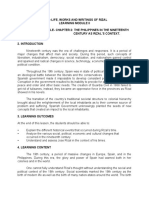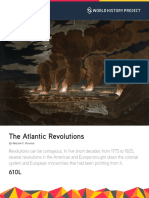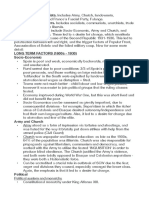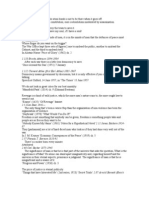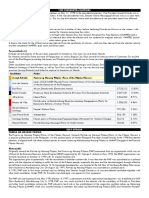Apuntes Tema 4 Siglo XX
Apuntes Tema 4 Siglo XX
Uploaded by
unidienteCopyright:
Available Formats
Apuntes Tema 4 Siglo XX
Apuntes Tema 4 Siglo XX
Uploaded by
unidienteOriginal Description:
Copyright
Available Formats
Share this document
Did you find this document useful?
Is this content inappropriate?
Copyright:
Available Formats
Apuntes Tema 4 Siglo XX
Apuntes Tema 4 Siglo XX
Uploaded by
unidienteCopyright:
Available Formats
1 Locate chronologically the Second Republic, the Civil war, the Franco
dictatorship and the transition to democracy.
Alfonso XII died
Military Coup
Dictablanda,
General Miguel
Primo de Rivera
Begining of Civil
Franco dies.
Transition starts.
M Cristina Regent
Queen
1874 1885
Restoration,
Alfonso XII
King 1874
1902
1923
1931 1936 1939
Alfonso XIII
becomes King
Republic II
1975 1978
End of
Civil War.
Begining
of Franco
s
Dictators
DEMOCRA
CY
2 Describe the main features of the reign of Alfonso XIII, including the Primo
de Rivera dictatorship.
During Alfonso XIIIs reign Spain experienced political and social conflict.
The Liberals and Conservatives continued to take turns in government (remember el pucherazo).
However, other parties opposed them: republican parties, nationalist parties in Catalua and Pas Vasco,
and the Socialist party.
Workers demanded better working conditions. There were many strikes (huelgas).
Spain was involved in military conflict in its new colonies in Morocco. Because of these problems, there
was a military coup in 1923. With Alfonso XIIIs support, General Miguel Primo de Rivera established a
dictatorship (dictablanda).
The constitution was suspended and
the king lost most of his powers.
Political parties became illegal.
Freedom of the press was limited by censorship.
At first, many people supported Primo de Riveras dictatorship.
Later on there was opposition from the army and from Alfonso XIII. Primo de Rivera resigned
in 1930.
3 Describe the reforms introduced during the Second Republic and their
consequences.
The Second Republic began in 1931 when the Republicans and Socialists won the municipal elections.
The monarchy was abolished.
Manuel Azaa became president.
There was a new constitution and Spain became a democracy: all men and women could vote. The most
important suffragette was Clara Campoamor.
The republic introduced many other changes too:
The Church lost control of education. Public schools were established. It was the time of
Institucin Libre de Enseanza.
There was more regional autonomy. There was a statute of autonomy for Catalua.
The Industrial Revolution also changed how society was organised.
A Reforma Agraria was proposed.
These reforms divided Spanish society and caused political conflict. Left-wing people generally supported
the changes. However, right-wing people opposed these changes.
Still there were many conflicts in Spanish society.
4 Explain some of the causes and consequences of the Spanish Civil War.
In July 1936 a military rebellion began in Spanish Morocco. Its leader was General Francisco Franco. The
rebels took control of parts of Spain. The country became divided between areas controlled by the
Nationalists, the rebels led by Franco, and areas controlled by the Second Republic.
The Spanish Civil War started because of the military rebellion led by Franco. Franco and the Nationalists
were opposed to the changes that the Second Republic had introduced. They wanted to replace the
republic with a right-wing dictatorship. The Republicans supported the Second Republic.
For three years there was fighting between the Nationalists and Republicans, until the Nationalists took
control of Madrid. The war ended in April 1939. As a result of the Nationalist victory, the Second Republic
ended. Franco established a right-wing dictatorship.
The war had other consequences too:
Around 365 000 people died.
Many people lost their families.
People were imprisoned or killed because of their opinions (Nationalists who lived in the
Republican zones, and Republicans who lived in the Nationalist zones).
Roads, bridges, railways and buildings were destroyed.
People became ill because there wasnt enough food.
5 Explain how Spain evolved during the Franco dictatorship.
6 Describe some of the milestones in Spains transition to democracy, such as
membership of the EU and the adoption of the euro.
7 Research and present information about the UN Universal Declaration of
Human Rights.
8 Recognise the main artistic and cultural movements of the 20th and 21st
centuries in Spain.
9 Describe some of the main features of contemporary Spanish society,
including the main problems facing present-day Spain.
10 Use vocabulary related to the curriculum block correctly.
You might also like
- Alexis de Tocqueville, Democracy in America and Two Essays On AmericaDocument1,122 pagesAlexis de Tocqueville, Democracy in America and Two Essays On AmericaTiffany Poon100% (2)
- Elwood - Lenin Nongeometric PDFDocument108 pagesElwood - Lenin Nongeometric PDFregistrocomteNo ratings yet
- The Challenge of DemocracyDocument27 pagesThe Challenge of DemocracyVarshini VarshNo ratings yet
- Taking The Risk Out of Democracy - Corporate Propaganda Versus Freedom and Liberty - Alex CareyDocument172 pagesTaking The Risk Out of Democracy - Corporate Propaganda Versus Freedom and Liberty - Alex Careylibrarian91187% (15)
- Unit 08. - Time of Conflict in SpainDocument6 pagesUnit 08. - Time of Conflict in SpainCelia GarcíaNo ratings yet
- UNIT 8 The First Third of The 20th Century in SpainDocument18 pagesUNIT 8 The First Third of The 20th Century in SpainJose PerezNo ratings yet
- Spanish Civil WarDocument76 pagesSpanish Civil WarMarcony Lopes Alves100% (2)
- UNIT 6 - SPAIN IN THE FIRST THIRD OF THE 20th CENTURYDocument6 pagesUNIT 6 - SPAIN IN THE FIRST THIRD OF THE 20th CENTURYteresa bascuñanaNo ratings yet
- SPANISH TRANSITION - Group 4Document23 pagesSPANISH TRANSITION - Group 4martacastellotlNo ratings yet
- Unit 7Document25 pagesUnit 7Bull 467No ratings yet
- Spanish Civil WarDocument4 pagesSpanish Civil WarIndrani GoswamiNo ratings yet
- Spain in The First Third of The 20th - PPTX 2 (Autoguardado)Document25 pagesSpain in The First Third of The 20th - PPTX 2 (Autoguardado)ariana.seguraNo ratings yet
- Background of The Spanish Civil WarDocument4 pagesBackground of The Spanish Civil Warlucas.sanz.lopezNo ratings yet
- The Causes of The Spanish Civil WarDocument4 pagesThe Causes of The Spanish Civil WarHazem EhabNo ratings yet
- Spanish FrancoismDocument2 pagesSpanish FrancoismSophie Cor - PéNo ratings yet
- The Spanish Civil War-For Whom The Bell TollsDocument7 pagesThe Spanish Civil War-For Whom The Bell Tollsvanilla_42kpNo ratings yet
- Class 9 historyNCERT SummaryDocument64 pagesClass 9 historyNCERT SummaryJYOTISH RAJNo ratings yet
- Collapse of Democracy - SpainDocument3 pagesCollapse of Democracy - SpainNico NajarroNo ratings yet
- Notes Unit 9. Spain, Times of Conflict (1898 - 1975)Document13 pagesNotes Unit 9. Spain, Times of Conflict (1898 - 1975)alison.cc2002No ratings yet
- Social Sciences 6 - Unit 2 - History of SpainDocument3 pagesSocial Sciences 6 - Unit 2 - History of SpainFátima DelgadoNo ratings yet
- Spanish Civil WarDocument47 pagesSpanish Civil Warcalvin8121No ratings yet
- Spanish Civil WarDocument35 pagesSpanish Civil WarCristian MateiNo ratings yet
- Spanish Civil WarDocument37 pagesSpanish Civil Warkungfu26No ratings yet
- 17th CommentaryDocument3 pages17th CommentarymodernnekaaaaNo ratings yet
- Unidad 2 HistoriaDocument5 pagesUnidad 2 Historiaandrescorralessanchez7No ratings yet
- French Revolution, 9, Ch-1Document2 pagesFrench Revolution, 9, Ch-1Khan ArshiNo ratings yet
- Spanish Civil War International Socialist Review Issue 24 Auto Saved)Document29 pagesSpanish Civil War International Socialist Review Issue 24 Auto Saved)pgallag1No ratings yet
- Long and Short Term Causes of The Spanish Civil WarDocument4 pagesLong and Short Term Causes of The Spanish Civil WarantopantoNo ratings yet
- Social Sciences 6 - Unit 1Document5 pagesSocial Sciences 6 - Unit 1Fátima DelgadoNo ratings yet
- Worksheet 3 - Louis-PhilippeDocument4 pagesWorksheet 3 - Louis-PhilippeMANAN SABHANINo ratings yet
- Apuntes Historia IDocument3 pagesApuntes Historia IADRIANA MARTIN VARONo ratings yet
- Span 407 - Contexto Historico - WinebrennerDocument4 pagesSpan 407 - Contexto Historico - Winebrennerapi-710918776No ratings yet
- FGGGFD 971Document280 pagesFGGGFD 971Bijelo DugmeNo ratings yet
- History of SpainDocument4 pagesHistory of SpaincatalinacresposolisNo ratings yet
- Philippines in The 19th CenturyDocument7 pagesPhilippines in The 19th CenturyGuevarra, Kristine Joy J.No ratings yet
- Class Notes The French RevolutionDocument3 pagesClass Notes The French Revolutionjacokec369No ratings yet
- Army Joel Mariano Topic-2Document10 pagesArmy Joel Mariano Topic-2Army Joel MarianoNo ratings yet
- Political Context 1830-1848 RevolutionsDocument9 pagesPolitical Context 1830-1848 RevolutionsMariaNo ratings yet
- Nationalism in SpainDocument2 pagesNationalism in SpainMaríaPGNo ratings yet
- Spain 4-6Document9 pagesSpain 4-6nimsat123No ratings yet
- History Term 1Document12 pagesHistory Term 1prahanyaasri.srinivasanNo ratings yet
- SP - Session 7 RepublicDocument64 pagesSP - Session 7 Republicapi-3734560No ratings yet
- class 9th history chapter-1,2,3 pdfDocument14 pagesclass 9th history chapter-1,2,3 pdfsaketkumardhruw09No ratings yet
- Aalekh Class 9th HistoryDocument64 pagesAalekh Class 9th HistoryAALEKH RANANo ratings yet
- WHP-1750 2-2-2 Read - The Atlantic Revolutions - 610LDocument6 pagesWHP-1750 2-2-2 Read - The Atlantic Revolutions - 610LOdelia SoleimaniNo ratings yet
- Causes of Spanish Civil War NotesDocument4 pagesCauses of Spanish Civil War Noteskiohni100% (2)
- 3 - The Restoration. Liberalism and NationalismDocument6 pages3 - The Restoration. Liberalism and Nationalismmarcosreni08No ratings yet
- Causes of The Spanish Civil WarDocument3 pagesCauses of The Spanish Civil Warnota nameNo ratings yet
- Chapter 2Document7 pagesChapter 2knghtwlkrsNo ratings yet
- Europe Faces Revolutions: Key Terms and PeopleDocument3 pagesEurope Faces Revolutions: Key Terms and PeopleGrace BuchananNo ratings yet
- The Triumph of Revolutions: The Most Shocking Revolutions in World HistoryFrom EverandThe Triumph of Revolutions: The Most Shocking Revolutions in World HistoryNo ratings yet
- Democracy and Dictatorship 1923-1939: Although Britain Stayed A Monarchy, The War Brought Changes in The CountryDocument9 pagesDemocracy and Dictatorship 1923-1939: Although Britain Stayed A Monarchy, The War Brought Changes in The CountryGemaNo ratings yet
- Spain in The First Third of 20th Century 1902-19391Document27 pagesSpain in The First Third of 20th Century 1902-19391Altan suvdNo ratings yet
- History NCERT Class 9Document27 pagesHistory NCERT Class 9123100% (1)
- Methods EssayDocument7 pagesMethods Essayapi-711549039No ratings yet
- SpanishcivilwarDocument6 pagesSpanishcivilwarapi-316694669No ratings yet
- Causes of The Spanish Civil WarDocument4 pagesCauses of The Spanish Civil Warrusseltarr100% (6)
- The French RevolutionDocument3 pagesThe French RevolutionShirley EstradaNo ratings yet
- 6769051a37350Document4 pages6769051a373502013d.dulamsuren.uNo ratings yet
- Nha-X Notes-Ch-1-HistoryDocument4 pagesNha-X Notes-Ch-1-Historyparubansal918No ratings yet
- RIZALG1ReportISUDocument50 pagesRIZALG1ReportISUshamrae716No ratings yet
- Student's Booklet: Spain in The 20th and 21st CenturiesDocument13 pagesStudent's Booklet: Spain in The 20th and 21st CenturiesrafakarmonaNo ratings yet
- PlantsDocument13 pagesPlantsunidienteNo ratings yet
- APUNTES Matter and LightDocument5 pagesAPUNTES Matter and LightunidienteNo ratings yet
- Teaching Reading: An Easy To Understand Explanation of Necessary Reading SkillsDocument6 pagesTeaching Reading: An Easy To Understand Explanation of Necessary Reading SkillsunidienteNo ratings yet
- I Get Ready For School: Unit Aims CompetencesDocument27 pagesI Get Ready For School: Unit Aims CompetencesunidienteNo ratings yet
- Annexe V Reading Comprehension: Answer The Following Questions and Check Your Answers by ReadingDocument1 pageAnnexe V Reading Comprehension: Answer The Following Questions and Check Your Answers by ReadingunidienteNo ratings yet
- Reading Text: Vocabulary Development: Match Each Word To Its DefinitionDocument1 pageReading Text: Vocabulary Development: Match Each Word To Its DefinitionunidienteNo ratings yet
- What I Know! What I Want To Know! What I Learned!Document1 pageWhat I Know! What I Want To Know! What I Learned!unidienteNo ratings yet
- Lesson Plan For The EFL ClassDocument6 pagesLesson Plan For The EFL ClassunidienteNo ratings yet
- Unit 7. Passives. Tenses ChartDocument0 pagesUnit 7. Passives. Tenses ChartunidienteNo ratings yet
- Jawaharlal Nehru - Culture 3 & 4Document9 pagesJawaharlal Nehru - Culture 3 & 4Sanatan Mandir School Parsippany NJNo ratings yet
- Capital in The Twenty-First CenturyDocument8 pagesCapital in The Twenty-First CenturyRaja ReddyNo ratings yet
- Letter Form Peggy WallaceDocument1 pageLetter Form Peggy WallaceMike CarpickNo ratings yet
- Sword and Swastica Telford TaylorDocument435 pagesSword and Swastica Telford TaylorAndemanNo ratings yet
- Elections and Political PartiesDocument35 pagesElections and Political PartiesMonic HoranNo ratings yet
- Friedrich Nietzsche: "The Gay Science", "Beyond Good and Evil", "The Genealogy of Morals" and "Anti-Christ"Document13 pagesFriedrich Nietzsche: "The Gay Science", "Beyond Good and Evil", "The Genealogy of Morals" and "Anti-Christ"Nico AndayaNo ratings yet
- China's Hundred-Year StrategyDocument4 pagesChina's Hundred-Year StrategyGerardo LagunesNo ratings yet
- History of Socialism - An Historical Comparative Study of Socialism, Communism, UtopiaDocument1,009 pagesHistory of Socialism - An Historical Comparative Study of Socialism, Communism, UtopiaMaks imilijanNo ratings yet
- Rock-Paper-Scissors SimulationDocument2 pagesRock-Paper-Scissors Simulationapi-312411440No ratings yet
- Manila Standard Today - Monday (November 5, 2012) IssueDocument18 pagesManila Standard Today - Monday (November 5, 2012) IssueManila Standard TodayNo ratings yet
- Article XDocument3 pagesArticle XKylie July100% (1)
- Digital DivideDocument28 pagesDigital DividejimmyNo ratings yet
- Transcending EconomiesDocument6 pagesTranscending Economiespiyush saxenaNo ratings yet
- HL History IB BismarckDocument3 pagesHL History IB Bismarckfs8085No ratings yet
- Pakistan Awami Tehreek Constitution (Dastoor)Document32 pagesPakistan Awami Tehreek Constitution (Dastoor)MinhajBooksNo ratings yet
- Dialectics of The Veil: Howard Winant PDFDocument17 pagesDialectics of The Veil: Howard Winant PDFMaiko CheukachiNo ratings yet
- 1.110 Brooks Atkinson 1894-1984: BaconDocument5 pages1.110 Brooks Atkinson 1894-1984: BaconsucihNo ratings yet
- Reviews Bangladesh: From Mujib To Ershad. An Interpretive StudyDocument3 pagesReviews Bangladesh: From Mujib To Ershad. An Interpretive StudyHanjala GalibNo ratings yet
- BRINKER - Linguistische Textanalyse (Caps. 4 y 5)Document19 pagesBRINKER - Linguistische Textanalyse (Caps. 4 y 5)antonella petruccelliNo ratings yet
- Liberalism Realism EssayDocument5 pagesLiberalism Realism EssayAytra00No ratings yet
- 25 - Renaissance and The Cult of PersonalityDocument9 pages25 - Renaissance and The Cult of PersonalityjitenderaNo ratings yet
- Merger of Princely States in OrissaDocument3 pagesMerger of Princely States in OrissaMalik MuttaherNo ratings yet
- Print PDFDocument9 pagesPrint PDFHemsley Battikin Gup-ayNo ratings yet
- Reaction PaperDocument2 pagesReaction PaperLaurice Jane NavarroNo ratings yet
- Chapter 7 - State and Society - All Politics Is Local, 1946-1964Document6 pagesChapter 7 - State and Society - All Politics Is Local, 1946-1964sjblora100% (2)






































